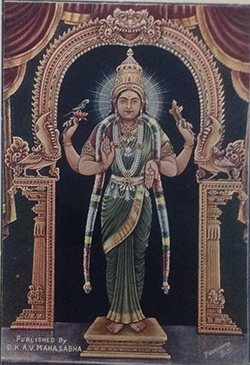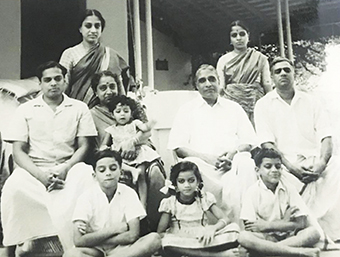The followers of Goddess Vasavi Kannika Parameswari hail from the Telugu speaking parts of our country. They migrated during the rule of Vijayanagar. These people have maintained their tradition while also adapting to Tamil culture. The Kula Devatas or family deities of these Telugu speaking people who moved over are fully located in Tamilnadu. The first tonsuring and ear piercing ceremonies of their children are done in these temples. These sacred thread wearing people pray in temples which are maintained by priests who do not wear the sacred thread (poonul). They respect these local priests enormously and treat them as part of their family. Goddess Ankala Parameswari is a popular family deity. In Coimbatore the Vysial Street Ankala Parameswari is among the nine sisters of the city.
The year for the people of Vysial Street begins with the Telugu New Year ‘Ugadhi’. Their almanac is based on the moon. The first item had by them on that day is known as ‘Chendhu’. This pulpy syrup conveys that life is a mixture of joy, sorrow and pleasure. The ‘Chendu’ is a mixture of all tastes and normally the priest makes it for them and hand delivers it. The community priest reads out the panchangam or almanac in the temple and also in individual houses. He shares details about the just born year. The details pertaining to rainfall, business, war, peace, good governance etc., will be read out. The listening to the details of the almanac is considered to be equal to having five baths in the River Ganges. The Indian Alamanac has been in vogue for thousands of years. In fact ancient Indians went all around the world and studied the movements of the sun, moon and stars in order to get a better understanding of the Universe. Some of these people did not return, while most of them did. A few from distant countries came along with our people and settled down in India. Generally people visited the local temple of Goddess Kannika Parameswari besides getting the blessings of their elders.
They celebrated the Tamil year with even greater gusto. People would wake up and first see an image of Goddess Lakshmi, have a bath, eat sweets and visit the temple of Goddess Koniamman – the tutelary deity of Coimbatore. Later during the day, the blessings of elders would be sought and the famous ‘Kaineetam’ would take place. The elders would give the younger people some money. Wealthier people used to give gold coins for ‘kaineetam’. Sometimes the kids used to get one per hand. All they had to do was to extend the other hand ! Three fruits used to offered at the pooja room and consumed. These fruits were known as ‘Mukkanigal’ (Ma – Mango, Pazha – Jackfruit and Vazhai – plantain). Most households used to make a nice salad of the three fruits for the kids particularly. The salad was loved by everyone.
The next occasion used to be the birthday of Goddess Vasavi Kannika Parameswari. Its a time when everyone would visit the temple, pray and have a huge meal in the temple itself. Its year long celebrations for these traders. ‘Naga Chathurthi’ will come after June and it is connected with being a kind person. The daughter in law or ‘Grihalakshmi’ is supposed to be the embodiment of love. This festival lays emphasis on that. The next festival is ‘Garuda Panchami’. Its when the women pray for the well being of their brothers. Its the ‘Brothers Day’. They get a gift and send it over to the brother. ‘Polala Gowri Vratam’ is for the well being of the children. The unmarried are given gifts that day. ‘Gowri Vratam’ is done in order to seek the well being of the husband and ‘Ganesha Chaturthi’ for the removal of obstacles. Another important festival is the ‘Shravanam’ when the men change the sacred thread or poonul after an elaborate pooja. ‘Gokulashtami’ is an occasion to celebrate the birth of Lord Krishna. He is welcomed with fruits, sweets, flowers and small impressions of his feet are made with aid of the fists of women or the feet of small kids at home.
‘Adi 18’ is another festival when they offer prayers to the well and other water bodies. The mercantile community have another role too and that is ‘Gosamraskshana’ or taking care of the cows. They are supposed to spend a part of their income for cowcare. Normally, they worship the cow everyday. However, they deck the cows with flowers and decorate the tails with turmeric and vermillion. An ‘arati’ is performed every Friday. A circumambulation is done when the cow delivers a calf for it is considered to be equal to going around the world. ‘Gaja Pooja’ or elephant pooja is also done on special occasions. The Tamil month of ‘Purattasi’ is sacred for they will create a resource for visiting ‘Tirumala Tirupati’ year on year. The Dasars or devotees of Vishnu will be given some provisions, fruits, vegetables, money etc., The Dasars will blow the conch and ring the musical plates with their wooden or metal sticks. ‘Mahalya Paksham’ would be for paying respects to the elders. The entire paksham or fifteen days will be for the same. They will do ‘Pithru Tharpanam’ everyday and will abstain from onion and garlic during this period. This is followed by ‘Navarathri’ and everyday a new offering is made to the Gods at home. They will visit the Vasavi Kannika Parameswari Temple every day at noon for the special pooja and Naivedyam.
—Rajesh Govindarajulu
Vysial Street Residents Keep Traditions Alive On Ugadi Fest – Part I




